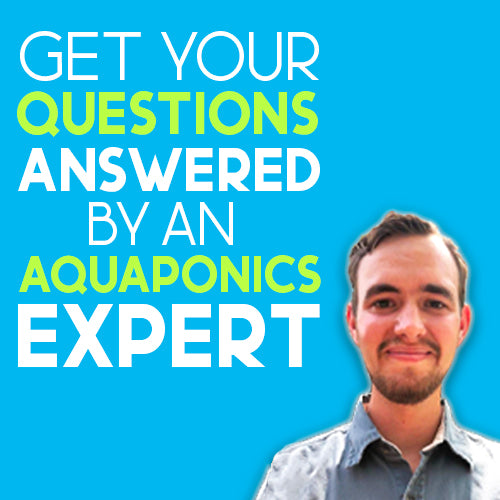When it comes to building a successful aquaponics system, most beginners focus on fish, plants, or grow beds and overlook one critical component: the water pump.
But here’s the truth:
A poorly chosen water pump can quietly sabotage your entire setup. It may not move enough water, causing ammonia to accumulate in your fish tank. Or it might push too much, flooding your grow beds and stressing your plants. Worse, it could fail suddenly, leaving your system dry and your fish gasping.
That’s why choosing the right pump is an important decision that can affect water circulation, oxygenation, filtration, and the health of every living part of your aquaponics ecosystem.
The good news? You don’t need to be a plumber or engineer to get it right.
This beginner-friendly guide will walk you through:
- What a pump does in an aquaponics system
- How to calculate the right size
- What features matter (and which are marketing fluff)
- The best pumps for small and mid-size systems
-
And how to avoid the most common and costly mistakes
Want to Save Time and Build It Right the First Time?
If you want to skip the trial and error and learn how to build a thriving aquaponics system, from pump sizing to full plumbing layouts, check this 5-hour premium video course just for you.
What Does a Water Pump Do in an Aquaponics System?
The pump moves water from the fish tank to the grow beds, where plants absorb nutrients from fish waste. Afterward, the water drains, usually via gravity, back into the fish tank or a sump tank for recirculation.
This closed-loop circulation:
- Delivers nutrient-rich water to plants
- Helps oxygenate water for fish
- Supports beneficial bacteria for biofiltration
- Prevents stagnation and harmful ammonia buildup
This process is what makes aquaponics so efficient and sustainable, and the pump is what powers it all.
Where the Pump Fits in Your Setup
There are a few common aquaponics layouts, but here’s a basic example of where the pump typically sits:
[Fish Tank] → (Pump) → [Grow Bed] → (Drain via gravity) → [Sump Tank or Fish Tank]

Tip:In small backyard or desktop systems, the pump is often located directly in the fish tank (submersible style). In larger or more complex builds, an inline pump located in a sump tank may be more efficient.
Factors to Consider When Choosing a Water Pump
Not all water pumps are created equal. To keep your aquaponics system running smoothly, you’ll need a pump that delivers the right amount of flow, handles your system’s layout, and won’t drain your power bill.Here’s what to look for when choosing the water pump for your system.
1. Flow Rate (GPH)
Gallons Per Hour (GPH) tells you how much water the pump can move in one hour. For most aquaponics systems, a good rule of thumb is to circulate the entire volume of your fish tank once every hour.
Example:
- If your fish tank holds 100 gallons, aim for a pump rated at least 100 GPH, but preferably 25–50% more to account for flow loss.
- Flow rate sweet spot: 1–1.5x your fish tank volume per hour
2. Head Height (or Head Pressure)
This measures how high your pump can push water vertically, and it’s often overlooked.The more height and resistance your pump has to overcome (pipes, filters, elbows), the lower the actual flow becomes. This is where many beginners underpower their systems.
Tip:Always check the flow chart provided by the manufacturer as it shows how much flow the pump delivers at different head heights (e.g., 1ft, 3ft, 5ft).
3. Energy Efficiency
Because your pump runs 24/7, energy use matters. Look for models labeled energy-efficient or with low wattage draw.
Consider:
- Wattage (lower is better for small systems)
-
Daily and monthly operating costs
- Whether your region supports solar backup or off-grid options
4. Submersible vs Inline Pumps
Both can work in aquaponics, but they suit different system types:
|
Type |
Ideal For |
Pros |
Cons |
|
Submersible |
Small to medium backyard systems |
Easy to install, quieter |
Limited head height, heats water |
|
Inline |
Large or commercial systems |
Powerful, cooler, scalable |
Requires external plumbing |
Recommendation:For most beginners, a submersible pump rated for aquariums or hydroponics is a great starting point.
5. Durability & Brand Reputation
Look for pumps that are:
- Fish-safe (no oil-based components)
- Corrosion-resistant (especially in systems with high humidity)
- Backed by a warranty or return policy
- Well-reviewed in aquaponics or hydroponic forums
6. Your System’s Design
Every aquaponics system is different. Consider:
- Do you use a sump tank?
- Are your grow beds above or beside the fish tank?
-
Are you running a constant flood or flood-and-drain system?
Common Water Pump Mistakes Beginners Make and How to Avoid Them
Below are the most common pump mistakes in aquaponics and how to avoid them.
1. Choosing the Wrong Size Pump
Most new growers either:
- Undersize the pump (leading to poor water flow and oxygen issues), or
- Oversize it (which creates turbulence, disturbs fish, and wastes energy)
What to do instead:
- Use the 1–1.5x tank turnover rule, and always factor in head height losses.
2. Ignoring Head Height & Plumbing Losses
Pumps rarely deliver their rated GPH in real-world conditions. Every vertical lift, bend, elbow, or valve adds resistance and lowers flow.
Solution:
- Map out your system plumbing
- Add 1 foot of head height per 10 feet of horizontal pipe or each 90° elbow
- Choose a pump with extra capacity to compensate
3. Running the Pump on a Bad Power Source
Power fluctuations or outages can fry a pump or cause total system failure, especially overnight.
Tip:
- Use a surge protector and GFCI outlet
- Consider a battery backup or solar system if you're in a rural or blackout-prone area
4. Using the Wrong Type of Pump
Not all pumps are suitable for aquaponics:
- Fountain pumps can clog easily or lack power
- Cheap pond pumps may overheat or contain oils harmful to fish
Look for:
-
Aquarium-grade or hydroponic pumps-safe materials
- Fish-safe materials
- Continuous-duty rated models
5. No Maintenance Plan
Over time, algae, fish waste, or debris can clog your pump’s intake which can reduce flow or burn out the motor.
Maintenance Tip:
- Clean the filter/screen every 2–4 weeks
- Visually inspect tubing and fittings
- Replace pumps every 12–24 months, depending on brand
The Best Water Pumps for Aquaponics
When it comes to aquaponics, choosing a reliable water pump is more than just picking a name brand. You want a pump that’s quiet, efficient, durable, fish-safe and most importantly, suited to your specific system size.
Below are 5 beginner-friendly water pumps that are trusted by aquaponics growers, including brands we’ve tested in our own systems.
1. EcoPlus Submersible Water Pump (Eco 396 – 594 GPH)
Best for: Small backyard or indoor systems (20–80 gallons)
Specs:
- Flow Rate:396 GPH
- Max Head Height:6.5 ft
- Wattage: 36W
- Type: Submersible
Pros:
- Affordable and reliable
- Quiet operation
- Comes with multiple outlet fittings
Cons:
- Not ideal for larger or multi-bed systems
- Plastic housing requires gentle handling
2. Active Aqua Submersible Pump (550 GPH)
Best for: Mid-size systems with 50–100 gallons
Specs:
- Flow Rate: 550 GPH
- Max Head Height:7.5 ft
- Wattage:32W
Pros:
- Energy-efficient
- Comes with a pre-filter sponge
- UL-listed and widely used in hydro setups
Cons:
- Slightly bulky for tight spaces
- Pre-filter may clog faster in high-solids systems
3. Jebao DCT Series Inline Pump (Variable Speed – 1056+ GPH)
Best for: Larger systems or users wanting high control
Specs:
- Flow Rate:Adjustable up to 1056 GPH
- Max Head Height:10–13 ft
- Type: Inline (external)
Pros:
- Quiet, powerful, and adjustable
- Digital controller
- Great for future expansion
Cons:
- Requires external plumbing setup
- Not fully submersible
4. Simple Deluxe Submersible Pump (400–1056 GPH Range)
Best for: Budget-conscious beginners with small to mid-sized systems
Specs (400 GPH model):
- Flow Rate:400 GPH
- Head Height: 6.9 ft
- Wattage: ~35W
Pros:
- Budget-friendly
- Multiple sizes to choose from
- Decent warranty
Cons:
- May require more frequent cleaning
- Mixed long-term durability reviews
5. Danner Supreme Aqua-Mag Magnetic Drive Pump
Best for: High-performance systems requiring durability
Specs (Model 5):
- Flow Rate: 500 GPH
- Head Height: 10 ft
- Type: Inline or Submersible (dual use)
Pros:
- Magnetic drive = quiet & energy efficient
- Long-lasting build
- Trusted by commercial aquaponics farms
Cons:
- More expensive than other beginner options

Frequently Asked Questions About Aquaponics Pumps
Here are some of the most common questions beginners ask with clear, concise answers you can trust.
1. How long should I run my water pump each day?
Answer:In most aquaponics systems, the pump should run 24/7.
Constant water circulation ensures:
- Oxygen-rich water for fish
- Consistent nutrient delivery to plants
- Stable biofiltration by beneficial bacteria
Exception: If you're using a timer-based flood-and-drain system, the pump may cycle on/off every 15–30 minutes.
2. What size pump do I need for aquaponics?
Answer:Choose a pump that can turn over your fish tank’s total volume once every hour, plus an extra 25–50% to account for head height and plumbing losses.
Example:
- 100-gallon fish tank → pump rated 125–150 GPH minimum
- Add more capacity if your grow beds are elevated or far from the tank
3. Can I use a pond or fountain pump?
Answer: Sometimes, but not always as it will depend on your system.
Many pond/fountain pumps are not designed for:
- Continuous use
- Fish-safe materials
- Handling solids or debris
Stick to pumps labeled as:
- Hydroponic-safe
- Aquarium-grade
- Continuous duty
4. What happens if my pump stops working?
Answer: If your pump fails:
- Water stops circulating
- Fish may suffocate from low-oxygen
- Grow beds may dry out
- Ammonia can spike and harm fish quickly
Always:
- Test your pump weekly
- Keep a backup pump on hand
- Use a surge protector and GFCI outlet
5. Do I need a timer for my pump?
Answer:Only if you’re using a flood-and-drain system with bell siphons.
Otherwise, most aquaponics pumps should run continuously. Timers are useful in:
- Media bed systems with manual flood-and-drain cycles
- Systems where pumps need rest periods for water to drain fully
6. How often should I clean my pump?
Answer:Check and clean the pump every 2–4 weeks, especially in warm climates or systems with:
- High solids from fish waste
- Algae growth
- Leaf debris
Remove the intake cover, rinse out the impeller housing, and scrub off buildup to prevent clogging or overheating.
Conclusion
Choosing the right water pump is one of the most important and most overlooked steps in setting up a healthy, productive aquaponics system. A well-sized, properly installed pump ensures:
-
Steady water flow
-
Consistent nutrient delivery
-
Healthy oxygen levels for fish
-
And peace of mind for you
You’ve just learned what most beginners don’t, how to size, select, and manage a pump that will serve your system for years.
But aquaponics success isn’t just about the equipment, it’s about understanding how the whole ecosystem works together.
Take the Next Step With Expert Support
If you're ready to move from research to results, we invite you to join a 5-hour premium aquaponics video course, trusted by beginners and backyard growers across the world.
 Enroll in the Aquaponics Course Now
Enroll in the Aquaponics Course Now
Your system deserves more than guesswork. Learn it the right way from day one.












Francky
September 06, 2023
Thank you for sharing this informative article on Water Pumps